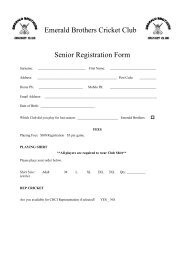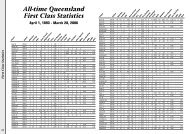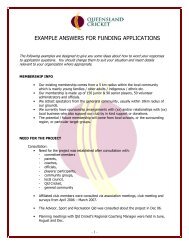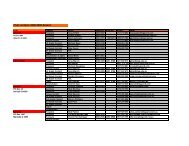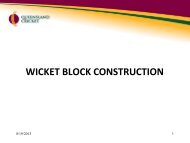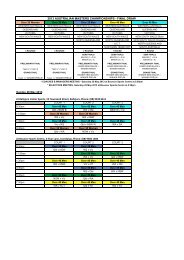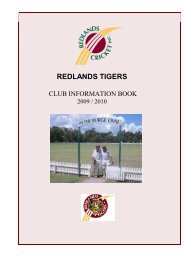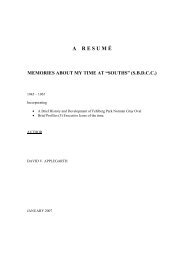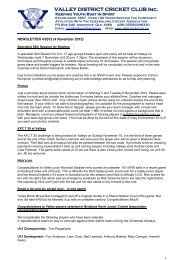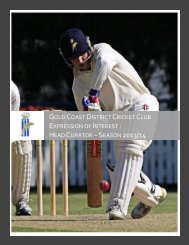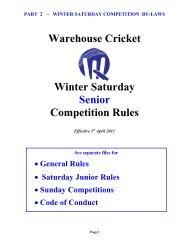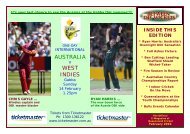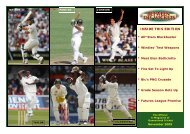-34-1968-<strong>2002</strong> ROGER PRENTICEABBREVIATIONSAR all rounder LAFB left arm fast bowlerRHB right hand batsman RAMFB right arm medium fast bowlerLHB left hand batsman LAMFB left arm medium fast bowlerRHOB right hand opening batsman RAOS right arm <strong>of</strong>f spinnerRHMOB right hand middle order batsman RALS right arm leg spinnerLHOB left hand opening batsman RAMB right arm medium bowlerLHMOB left hand middle order batsman LAMB left arm medium bowlerRHUOB right hand upper order batsman LASB left arm slow bowlerLHUOB left hand upper order batsman LAIB left arm inswing bowlerRAB right arm bowler LAFMIB left arm fast medium inswing bowlerRAFB right arm fast bowler WK wicket keeperOn field success is best judged by premierships won and players graduating to play representative<strong>cricket</strong>. During this period <strong>the</strong> <strong>club</strong> has won three <strong>club</strong> championships (1987-8, 1993-4, 1997-8), one firstgrade (1987-8, eleven overall), one second grade (1992/3, six overall), one third grade (1993-4, sevenoverall), one fourth grade (1986-7, three overall), two fifth grade (1981-2, 1997-8, two overall), two sixthgrade (1995-6, 1996-7, two overall), one U19 (1992-3, one overall), two U17/18 (1972-3, 1982-3, nineoverall), two U15/16 schoolboys (1994-5, 1995-6, three overall) and <strong>the</strong> only women’s premiership (2001-2). The One Day Knockout competition was won in 1988-9. The term three peat is used to indicate <strong>the</strong>three premierships in a row in sixth, sixth and fifth grades won by predominantly <strong>the</strong> same grup <strong>of</strong> playersin 1995-8.During this period, three current players played test <strong>cricket</strong> for Australia, Gary Cosier (two seasons),Craig McDermott (two seasons) and Carl Rackemann (10 seasons). Because <strong>of</strong> Test and statecommitments <strong>the</strong>se players played relatively little <strong>cricket</strong> for <strong>the</strong> <strong>club</strong>. Ray Phillips toured England in1985 with <strong>the</strong> Australian team as understudy wicket keeper and played seven seasons with <strong>the</strong> <strong>club</strong> aftermoving from NSW.During <strong>the</strong> period an additional ten players played for <strong>the</strong> state whilst playing for WSDCC. They wereTim Caban, Darren Kingdon, John Loxton, Michael Maranta, John Maguire, David Rathie, GregRowell, Chris Smart, Sam Trimble, Dirk Tazelaar whilst Jim Hunter and Brett Stephenson were 12 thmen for Queensland. The 2001-2 womens team contained six current State players.Compared with <strong>the</strong> overall <strong>history</strong> <strong>of</strong> <strong>the</strong> <strong>club</strong> <strong>the</strong> on field successes have been relatively sparse.However a highlight has been <strong>the</strong> three <strong>club</strong> championships and in particular <strong>the</strong> lower gradeperformances from 1985-6 onwards when <strong>the</strong> <strong>club</strong> has only been lower than fourth in <strong>the</strong> <strong>club</strong>championship on five occasions. The first grade premiership in 1987-8 was a major highlight which was<strong>the</strong> culmination <strong>of</strong> a dramatic overall improvement in all grades’ performances over <strong>the</strong> preceding threeseasons. The arrival <strong>of</strong> John Bell as coach, captain, recruiter and motivator was not a coincidence with<strong>the</strong> success in this period. Ano<strong>the</strong>r highlight was winning <strong>the</strong> one day final in 1988-9. The <strong>club</strong>’s firstgrade team won <strong>the</strong> minor premiership in 1975-6 and were beaten finalists under <strong>the</strong> enthusiasticleadership <strong>of</strong> John Loxton and again <strong>the</strong> <strong>club</strong> was beaten finalist in 1980-1 in a match in which ChrisSmart scored a century and 98 which was <strong>the</strong> springboard to his first class career. In 1993-4 afterfinishing <strong>the</strong> fixtures in second place, <strong>the</strong> Jon Dooley led team was a beaten semi-finalist to a Universityteam which contained six state representatives. In 2001-2 Greg Rowell also took his team to <strong>the</strong> grandfinal.One way to examine <strong>the</strong> best individual players <strong>of</strong> <strong>the</strong> era is to choose <strong>the</strong> best team based on <strong>club</strong>performances. Ra<strong>the</strong>r than choose <strong>the</strong> best team, two teams have been chosen. Cosier and Maguirehave been excluded because <strong>of</strong> <strong>the</strong> relatively small amount <strong>of</strong> <strong>cricket</strong> played for WSDCC and for similarreasons Rackemann has been chosen in <strong>the</strong> second team. The teams are:S C TrimbleJ M WalkerJ F C LoxtonA J BaileyC B SmartJ A HunterD S RathieR D LuptonD A TuckwellP J CameronM G MarantaB R StephensenJ C Bell (C)M D ThompsonG J RowellR B PhillipsC E WestawayJ B Dooley (C)D TazelaarJ E BourkeP W DonaldsonC G Rackemannth12 T K Cabanth12 N BelousIn this era it can be argued that <strong>the</strong> best non chosen fieldsman should be <strong>the</strong> 12 men. If that were <strong>the</strong>thcase, <strong>the</strong> first team’s fieldsman would be S J Paulsen and <strong>the</strong> second team’s A J Taylor.Sam Trimble was a stalwart for WSDCC and whilst his best years were prior to 1968-9, he still was amagnificent player for <strong>the</strong> next six seasons. His best shot was <strong>the</strong> cut shot in which he relished anythingslightly short outside <strong>the</strong> <strong>of</strong>f stump by even <strong>the</strong> fastest bowlers. He easily tops <strong>the</strong> <strong>club</strong> averages forplayers who have scored more than 1500 runs and gave his utmost for his <strong>club</strong> when state commitmentspermitted. Sam is <strong>the</strong> tenth highest run scorer in interstate <strong>cricket</strong> <strong>history</strong> with 8647 runs at 39.85. Allexcept Cox have played test <strong>cricket</strong>. Arguably Sam Trimble is <strong>the</strong> best batsman in Australia’s 126 year<strong>history</strong> not to have played test <strong>cricket</strong>. He toured <strong>the</strong> West Indies in 1965, topping <strong>the</strong> tour averages but
-35-was kept out <strong>of</strong> <strong>the</strong> test team by Simpson and Lawry. His son Glenn who was <strong>of</strong>ten seen at Gracevilleas a young boy played 87 games for Queensland but while playing for Souths.Toge<strong>the</strong>r with Sam, John Loxton formed a formidable opening partnership for both Wests andQueensland. Their best for Wests was 231 v Colts in 1968-9. John scored 100 on debut for Queenslandin Perth in 1966-7 and after Sam left <strong>the</strong> <strong>club</strong> elected to bat down <strong>the</strong> order. But for a life threateninghead injury when hit whilst batting, it is likely John would have scored far more than his 1081 runs forQueensland and may have played for Australia. A feature <strong>of</strong> his play was his exquisite timing. He gave<strong>the</strong> <strong>club</strong> sterling service both on and <strong>of</strong>f <strong>the</strong> field over a period <strong>of</strong> 16 years.As mentioned earlier, <strong>the</strong> 1980-1 grade final was <strong>the</strong> springboard for Chris Smart’s interstate careerconsisting <strong>of</strong> 32 matches over eight seasons. His best match was probably <strong>the</strong> 1983-4 Sheffield finalwhen he impressed no lesser a judge than Dennis Lillee with half centuries in each innings. As aschoolboy Chris was a fast bowler but <strong>the</strong>n turned into a very fluent and attacking upper order batsman.In <strong>the</strong> latter half <strong>of</strong> his career he greatly tempered his stroke play. His best year was 1983-4 when hescored 601 runs at 66.77 having captained Queensland Colts <strong>the</strong> previous season. One <strong>of</strong> Chris’ majordisappointments was missing <strong>the</strong> 1987-8 premiership win when he played a season for Richmond inMelbourne. He had some recompense <strong>the</strong> next season when he captained <strong>the</strong> <strong>club</strong> to a one day knockoutwin.David Rathie started his grade career with Easts where he first played for Queensland as a 19 year old.He played eight seasons for WSDCC before moving to Valleys. As a schoolboy, he was rated by hiscoach, Mo Hansen as a better batsman than <strong>the</strong> Archers, Burge, Ray Reynolds and Ogilvie but hisstudies to become a lawyer and his international Rugby Career hampered his development. He suffereda severe rugby injury to his throat. As well as playing eight games for Queensland, he played first class<strong>cricket</strong> in New Zealand in 1978-80. His best season was 1976-7 when he scored 593 runs for 53.90,winning him selection for <strong>the</strong> Queensland Sou<strong>the</strong>rn Tour. Early in his career he was an attacking No 4batsman but towards <strong>the</strong> end became an impenetrable opener. He used to practice like Boycott for hourson end having o<strong>the</strong>r players throw balls at him.With <strong>the</strong> advent <strong>of</strong> John Bell to WSDCC, Dean Tuckwell transferred from Norths as a 19 year old in<strong>the</strong> hope that like Ritchie and Rackemann, this would lead to international honours. It was not to be butalong <strong>the</strong> way he rightly earned <strong>the</strong> reputation <strong>of</strong> one <strong>of</strong> <strong>the</strong> most fearful and hardest hitters to play grade<strong>cricket</strong>. He impressed good judges during his three year stint in league <strong>cricket</strong> in <strong>the</strong> north <strong>of</strong> England(when he played as an amateur) to <strong>the</strong> extent that he was <strong>of</strong>fered pr<strong>of</strong>essional contracts to follow in <strong>the</strong>footsteps <strong>of</strong> overseas test players. Dean has built up a magnificent record for Wests and if he had notspent three seasons playing and living on <strong>the</strong> Sunshine Coast (when he was named in that <strong>club</strong>’s team<strong>of</strong> <strong>the</strong> century) would hold <strong>the</strong> <strong>club</strong>’s first grade run scoring record. Dean has kept his best for <strong>the</strong> goodbatting wickets, <strong>the</strong> big occasion or <strong>the</strong> big reputation <strong>of</strong> an opposing bowler. As a 19 year old he playeda grafting innings <strong>of</strong> 48 on Graceville No 2 against Craig McDermott when <strong>the</strong> latter was at <strong>the</strong> peak <strong>of</strong>his ability, not giving an inch and not looking like getting out. Both Michael Kaprowicz and Andrew Bichelhave felt <strong>the</strong> wrath <strong>of</strong> Dean’s bat, <strong>the</strong> former in a fashion more severe than on any o<strong>the</strong>r occasion exceptthan V V S Laxman’s double century for India.Dean played important innings in <strong>the</strong> semifinal and final in <strong>the</strong> premiership winning team <strong>of</strong> 1987-8 andscored a magnificent century in <strong>the</strong> one day win at <strong>the</strong> Gabba <strong>the</strong> following year. His highest score <strong>of</strong>166 was scored on a belter at University but he also played a magnificent innings on a poor wicket in <strong>the</strong>1993-4 semifinal loss.Dean was still at it in 2001-2 when he scored a century between tea and stumps in Round 2 againendangering <strong>the</strong> RSL Memorial at Deep Cover at Graceville with his six hitting. When all seemed los<strong>the</strong> scored 98 (run out) spearheading his team to 239 runs between start <strong>of</strong> play and lunch in <strong>the</strong> secondinnings <strong>of</strong> <strong>the</strong> 2001-2 grand final. Again he reserved special attention for ano<strong>the</strong>r state player, (andWests old boy as an 18 year old whilst at <strong>the</strong> Oxley Police Academy) Brendan Creevey. Early in hiscareer his specialty shot was a l<strong>of</strong>ted cover drive in <strong>the</strong>ir first over whilst opening <strong>the</strong> innings. Later, hebatted in <strong>the</strong> lower order and hit his shots straighter but still on <strong>the</strong> <strong>of</strong>fside. No greater compliment couldbe paid than when his teammates led by Jon Dooley used to sit up and watch as if transfixed, when Deangot into full swing. With a little luck at <strong>the</strong> right time he would undoubtedly have played for Queensland,and with <strong>the</strong> benefit <strong>of</strong> <strong>the</strong> better wickets at first class level, probably Australia. Dean did play for <strong>the</strong>Queensland Second XI.Michael Maranta commenced his first grade career at Wynnum but came to Wests to join his friend,Chris Smart. He played three matches for Queensland making a ra<strong>the</strong>r unusual debut whilst replacingJohn Maguire who had been called up for Australian duty. What was unusual was that John had alreadycommenced playing in <strong>the</strong> XI in <strong>the</strong> match in Melbourne for Queensland. Michael was an excellent LAIBbut as well opened <strong>the</strong> batting for much <strong>of</strong> his career. It was only fitting that he played a major role in <strong>the</strong>1987-8 premiership win.John Bell’s best days were well behind him when he came to Wests from Norths via Wynnum Manlyin 1985-6. Along <strong>the</strong> way he had won a swag <strong>of</strong> premierships, transformed Wynnum Manly and identifiedand nurtured <strong>the</strong> three test players (including John Maguire) as well as a multitude <strong>of</strong> state players. Asa captain/coach his record is <strong>the</strong> best <strong>of</strong> anyone’s in <strong>the</strong> 104 year Brisbane Grade Cricket Competition.Many argued he was a superior player to John Maclean who played 96 matches for Queensland and ahandful <strong>of</strong> tests for Australia. John Maclean kept John Bell, also a WK/batsman out <strong>of</strong> <strong>the</strong> QueenslandTeam. As a result <strong>of</strong> his success with WSDCC, John Bell was promoted to Queensland State Coach in1988-9 and missed making a home Sheffield Final, (which if played in Brisbane would have been washedout) by a handful <strong>of</strong> runs. As it turned out, Queensland did not even make an away final. In acrimoniouscircumstances, John Bell was sacked as Queensland Coach.As detailed earlier Wests made dramatic improvement in his three years at <strong>the</strong> helm and it was atestimony to <strong>the</strong> team spirit and even playing strength <strong>of</strong> <strong>the</strong> 1987-8 premiership team that not a single



